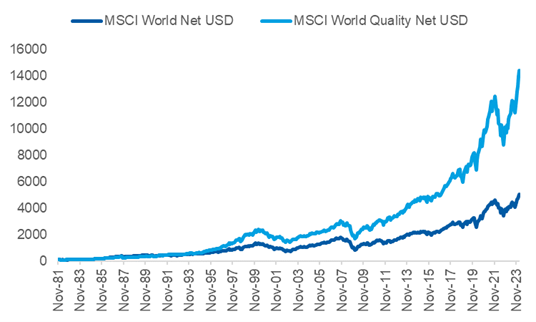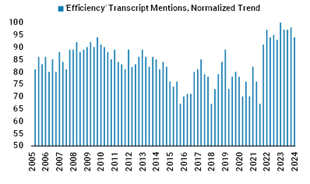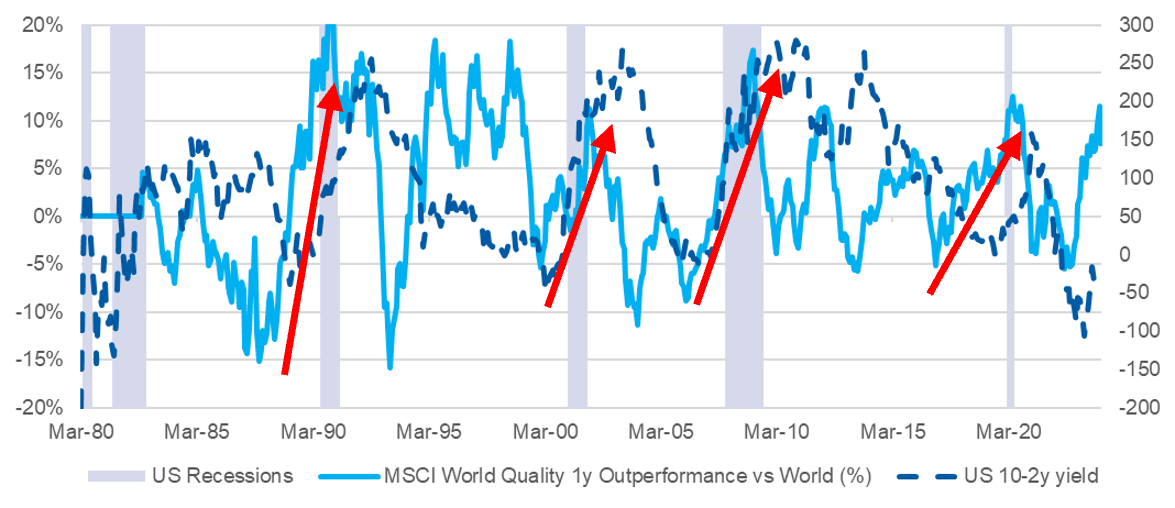How to make quality investing a profitable habit (and 7 ideas)
Quality factor investing has historically resulted in superior outcomes over the long run and has also been a recent outperformer within equity factor investing. This paper investigates the drivers, outlook, and presents two managed funds, two exchange-traded funds as well as three stocks that provide exposure to the Quality factor.
Background
Factor investing refers to targeting specific "style" or characteristics of investments that are defined by a shared driver of investment risk and return. These factors include Value, Growth, Momentum, Low Volatility and Quality, which all capture a risk premium. Each factor style has its own metrics that define what constitutes the respective style.
What precisely defines Quality is generally more openly debated among investors than other investing styles. Essentially, Quality investing comes from the tendency for profitable, stable, growing and well-governed high-quality companies to outperform their "lower quality" peers over the long run (see Quantitative Equity Research: Australian Factor Guide: Signaling Strength Within, March 10, 2020).
The quality of a company is a measure of its operations and ability to deliver strong results irrespective of changes in market conditions. Quality companies can be filtered based on certain metrics related to their balance sheet and income statements.
While some investors may use a broader definition, for this exercise, we adopt MSCI’s definition. This sets out three distinct quantitative factors:
- High return on equity (ROE),
- Strong and stable earnings per share (EPS) growth, and
- Lower leverage than their peers (see the methodology in the Appendix).
However, quality companies are more than just business entities with strong balance sheets and profitability. Quality companies tend to show strong, durable business models, operational efficiency and sustainable competitive advantages which essentially drive superior profitability over the longer term. This intuitively should result in greater long-term performance. This is confirmed historically, with the MSCI World Quality NR USD Index significantly outperforming the MSCI World Net USD Index since its inception in November 1981 (see Figure 1).
Figure 1: Over the long run, quality investing has generated substantial value over traditional.

Source: MSCI, Bloomberg, MSWM Research. Data as of February 29, 2024. Indexed at 100 on 30/11/1981. Past performance is not an indicator of future performance. The normalised trend is calculated as a function of the number of documents containing hits on the keyword and the total documents that would be found for the same search without the keyword. Searches are inclusive of synonyms. Universe is US public companies with market caps >US$1B, excluding Financials. ‘Efficiency’ transcript searches also exclude Energy and Utilities.
Besides profitability, another main criterion driving "quality" investing is high operational efficiency, which we see as an extension of the Quality factor and has been readily evident in the recent performance of equities.
Operational efficiency has been a key focus of many corporations in financial reports, as companies continue to invest in technologies such as artificial intelligence (AI) to improve productivity.
Cohorts that have recently emphasised operational efficiency include Software, Professional Services, Healthcare Services, and Financial Services (see US Equity Strategy: Weekly Warm-up: A Premium on Quality, February 12, 2024).
Figure 2: Mentions of 'Efficiency' sustaining near historical highs

Source: Haver Analytics, Morgan Stanley Research. The normalised trend is calculated as a function of the number of documents containing hits on the keyword and the total documents that would be found for the same search without the keyword. Searches are inclusive of synonyms. Universe is US public companies with market caps >US$1B, excluding Financials. ‘Efficiency’ transcript searches also exclude Energy and Utilities.
When to pay for Quality
Although Quality factor investing has outperformed traditional investing over the long run, it is also considered a defensive factor. Based on historical data, the Quality factor has tended to perform better late cycle and into a recession - i.e. when the economic impulse is the least supportive. Generally, this is when companies with steadier balance sheets, and potentially stronger franchises, manage to overcome economic weakness and deliver stronger profit than peers. In short, they are less cycle-sensitive, as opposed to the Size and Value factor for example.
Figure 3: Quality traditionally outperforms in later-stage economic expansion and into recession

Source: MSCI, Bloomberg, MSWM Research. Past performance is not an indicator of future performance.
In particular, we have been overweight the Quality factor for over a year, given:
- The greater exposure to stocks benefiting from key emerging secular tailwinds (for example, AI and weight loss drugs); and
- Quality is traditionally a late-cycle outperformer.
A recent report by our CIO Mike Wilson (see US Equity Strategy: Weekly Warm-up: When in Doubt, January 22, 2024), highlights this view, showing that Quality Growth has historically delivered double-digit relative returns over lower quality and more cyclical peers in decelerating front-end interest rate regimes (based on equal-weight factor performance). Importantly, this dynamic typically remains for over a year.
Figure 4: Quality Growth tends to show strong relative returns in decelerating front-end interest rate regimes.

Source: Compustat, Morgan Stanley Research. Front-end rates are 1-year Treasury yields. Past performance is not an indicator of future performance.
Therefore, in an environment where front-end rates have likely peaked, together with the start of a Federal Reserve rate-lowering cycle, Quality Growth is expected to continue showing strength. Morgan Stanley currently sees the potential for this outperformance to increase into double digits.
Many lower quality, economically sensitive areas of the market outperformed during the final two months of 2023. But we believe this was mainly driven by short covering and "performance-chasing" into the year-end rather than a more sustainable change in leadership based on a full reset of the cycle.
So far in 2024, the "laggards" of 2023 are back to lagging and the "winners" are back to winning (see Asset Allocation Insights: Joining The Dots: The Magnificent One, March 1, 2024). In particular, earnings revisions for Quality Growth stocks in the most recent US reporting season indicated a likely further upside in relative performance.
Figure 5: Relative US earnings revisions have been strong for Quality Growth

Source: Compustat, Morgan Stanley Research. Past performance is not an indicator of future performance.
In terms of global sectors, Morgan Stanley found the most attractive risk/reward compositions are currently in Software & Services, Capital Goods as well as Commercial and Professional Services. Software is currently our preferred segment of the Growth equity universe and is likely to be a key driver of Quality factor relative outperformance moving forward.
Investment Conclusion
Given that corporate earnings are nominal, they are likely to face headwinds from falling real GDP growth and inflation forecasts this year. In particular, this is within an environment where the US consumer (~70% of the economy) will continue to be impacted by higher interest rates and rising unemployment. In this context, we continue to focus on sectors and regions that offer secular tailwinds and earnings resilience (e.g. Technology, AI, segments of the Healthcare sector) – which are significantly represented in the Quality factor.
How we invest in the Quality theme
Managed Funds and Exchange Traded Funds (ETFs)
GMO Quality Trust - APIR: GMO1447AU
MSWM Research PIC Status: Approved – Focus List
The GMO Quality Trust uses a combination of quantitative screening and fundamental analysis to construct a concentrated, high-conviction global equity portfolio of around 50 securities. The Strategy aims to invest in stocks exhibiting Quality characteristics such as high rates of return on capital and low leverage, while adhering to a strong valuation discipline to reduce downside risk.
The Trust is currently our preferred International Equities – Large Core (Quality) strategy due to its hybrid approach combining a robust and proprietary systematic process with fundamental analysis that adheres to a well proven investment philosophy. The Trust’s competitive pricing coupled with the experience and co-tenure of the lead portfolio managers further underscores our positive score and inclusion in the Focus List.
GMO’s systematic definition of Quality is open to stocks of all styles (Core, Growth or Value) and employs an array of measures designed to filter stocks based on the following characteristics:
- Stable profitability
- High profitability
- Balance sheet strength
- Attractive valuation.
The underlying Strategy has adopted an increased emphasis on fundamental analysis over the last decade to distinguish itself from factor portfolios. As a high-conviction, bottom-up investment manager, the investment approach used by the Trust is research intensive.
When viewed through an equity factor lens, this Strategy applies a systematic ‘Quality’ filter to identify companies with historical profitability metrics, overlaid with a fundamental analysis of quality and valuation characteristics.
The Trust aims to outperform the MSCI World ex-Australia Index NR (AUD) Index by 3% p.a. (net of fees) over rolling five-year periods and has a 0.6% p.a management fee. For further details see Managed Fund Research Report: GMO Quality Trust Review, December 20, 2023).

Fairlight Global Small & Mid Cap Fund - APIR: PIM7802AU (Class A, unhedged) and APIR: PIM0941AU (Class H, hedged)
MSWM Research PIC Status: Approved – Focus List
The Fund invests in a portfolio of 30-40 global small and mid-capitalisation companies drawn from international equity markets using a concentrated, long only strategy grounded in fundamental research with a strong focus on Quality.
As a bottom-up investment manager, Fairlight employs a process that focuses on stock selection at the individual company level rather than considering macroeconomic and sector trends.
The investment team seeks to invest in Quality stocks that are attractively valued and, as such, targets companies with the following characteristics:
- Business-to-business contracts/relationships
- Direct sales force
- Recurring or contracted revenues
- Client purchasing decision is an operating one rather than a capex/allocation decision
- High value-to-cost ratio for clients/shared benefits
- Products or services that command pricing power.
The investment team takes the view that these Quality attributes are often found in the Consumer, Media, Light Industrial, Technology and Healthcare sectors. The investment team targets three types of investment opportunities: High Quality Growth companies, Stable Compounders and Low Risk turnarounds/special situations.
Expected returns are 3-5% above the MSCI World SMID AUD NR Index before fees over the investment cycle (seven years). The Fund charges a management fee of 1.25% p.a., an administration fee of 0.05% p.a. and a currency hedging fee of 0.1% p.a. A performance fee of 15% is incurred on the amount by which the Fund outperforms (MSCI World SMID AUD NR Index), provided any underperformance from previous periods has been recovered. For further details see Managed Fund Research Report: Fairlight Global Small & Mid Cap Fund, February 7, 2024).
VanEck MSCI World International Quality ETF - (ASX: QUAL) (unhedged) and (ASX: QHAL) (hedged)
MSWM Research PIC Status: Approved – Focus List
QUAL.AX is on our ETF Focus List and is currently our preferred passive exposure to the quality factor. The ETF tracks the MSCI World ex-Australia Quality Index in Australian dollars and has a 0.4% management fee.
The underlying index starts with an investable universe of large and mid-cap securities across 22 Developed Market countries (excluding Australia) and covers approximately 85% of the free float-adjusted market capitalisation in each country.
The Quality investment style characteristics are defined and given a score based on three metrics: ROE, earnings variability and leverage. The three metrics are averaged to generate a cumulative score of Quality.
QUAL holds a portfolio of ~300 international equities displaying three quality fundamentals: 1) high ROE; 2) stable year-on-year earnings growth; and 3) low financial leverage. Equity exposure is focused on the US and within the IT and Healthcare sectors. QUAL is our preferred ASX-listed Global Quality Factor ETF due to its strong Quality capture, competitive pricing and attractive liquidity profile.
The ETF exhibits a higher level of concentration risk relative to the MSCI World ex-Australia Index; with approximately ~33% of the portfolio invested in IT, ~21% invested in Healthcare and ~77% in US-listed securities. QUAL.AX is unhedged, the majority of the assets are denominated in non-Australian dollar currencies and the portfolio is rebalanced semi-annually. QUAL.AX is the preferred ETF in this category. For further details see ETF Research Report: International Quality ETF Review, January 2, 2024.


Betashares Australian Quality ETF – (ASX: AQLT)
MSWM Research PIC Status: Approved
AQLT.AX is on the Morgan Stanley Approved Product List and is the only explicit Australian Quality ETF listed in Australia. AQLT.AX uses a bespoke index, the Solactive Australia Quality Select Index. This index tracks the performance of 40 high-Quality companies based on three metrics – High ROE, low leverage and relative earnings stability. This index has a very different composition to the comparable MSCI Index due to a lower large-cap bias. This ETF’s composition across sectors is ~34% Financials, ~13% Materials and ~11% Consumer Discretionary (see ETF APL: Exchange Traded Approved Product List, March, 2024.

Direct Equities
Amazon.com Inc. (NASDAQ: AMZN)
Morgan Stanley Rating: Overweight
Price Target: US$200.00
Amazon.com Inc. (AMZN.O) is the leading e-commerce provider for physical and digital merchandise as well as a pioneer for enterprise cloud computing solutions. A member of the ‘Magnificent 7’, AMZN.O has been a Morgan Stanley Top Pick since September 13, 2023.
In FY23, AMZN.O had a ROE of 17.5% and Morgan Stanley forecasts this metric to increase to 20.3% by FY24. AMZN.O reported a FY23 EPS of US$2.90 and this is projected to grow considerably over the next few years with Morgan Stanley forecasting an EPS of US$7.10 in FY26.
AMZN.O's high-margin businesses continue to allow the company to drive greater profitability while still continuing to invest in its diversified business model. Amazon Prime membership growth has been driving recurring revenue while the cloud business has reached an inflection point. The impact of cost optimisations continues to diminish, and the pace of new deals, initiatives, and existing migrations to the cloud is accelerating. Morgan Stanley expects these trends and growing Generative AI offerings to lead to a continued acceleration in 2024. For further details see Amazon.com Inc: Even Higher North Stars, February 2, 2024.
Costco Wholesale Corp. (NASDAQ: COST)
Morgan Stanley Rating: Overweight
Price Target: US$780.00
Costco Wholesale Corp. (COST.O) is a major US food retailer and is currently rated Overweight by Morgan Stanley. The company currently comprises ~1.5% of the MSCI World Quality index and was highlighted in Morgan Stanley’s Quality Growth screen as falling in the top two quantiles of Quality Growth companies (see US Equity Strategy: Weekly Warm-up: When in Doubt, January 22, 2024).
In FY23, COST.O had an ROE of 28.6% which is expected to remain relatively stable over the next 3 years. For FY23 the EPS for the stock was US$14.69 and is forecast by Morgan Stanley to grow consistently over the next 3 years.
COST.O's results have consistently been among the best in Retail. Over the past decade, COST.O has delivered ~10% EBIT growth on average. In particular, COST.O has solid comp/membership growth, while relative e-commerce insulation differentiates its value proposition from other retailers. In the near-term, Morgan Stanley expects incremental sales uplifts, and earnings power looks stronger despite elevated inflation in the business. For further details see Costco Wholesale Corp: Changing of the Guard, February 6, 2024
Premier Investments Ltd (ASX: PMV)
Morgan Stanley Rating: Overweight
Price Target: A$32.00
Premier Investments (PMV.AX) is an investment holding company with assets including the Just Group, an operator of seven different retailers (Just Jeans, Jay Jays, Portmans, Jacqui E, Dotti, Peter Alexander, and Smiggle), a ~26% ownership in white goods manufacturer Breville Group Ltd, and ~A$400m in net cash. Like many of the domestic retailers, PMV.AX’s sales surged amid the strong re-emergence of the consumer following the pandemic response. In particular, PMV.AX’s key growth asset, Smiggle, has the potential to provide offsetting sales growth in the event of a consumer downturn and is growing at an accelerating pace. In addition, PMV.AX has upside potential that could be unlocked through a potential demerger (see Premier Investments: Lots of Levers, September 28, 2023).
PMV.AX is currently trading on a valuation of ~14-15x FY23 P/E (ex-cash and investments), which is in line with the Small Cap Retail universe based on Morgan Stanley forecasts, although viewed as attractive in the context of the company’s key drivers. PMV.AX’s FY23 EPS was A$1.41, with a ROE of 16.8%. In 2023, PMV.AX commenced a strategic review focusing on Peter Alexander, Smiggle, and Apparel. The review considered a range of options including a demerger into two or more distinct entities. Morgan Stanley is of the view that a potential demerger could highlight underlying value in Peter Alexander and Smiggle, which are arguably two of the highest-quality retail formats in Australia. The Morgan Stanley bull case (A$41.00 per share) assumes a demerger and cyclical recovery (FY24e EBIT +10% y/y). If the status quo holds and there is no demerger, and cyclical headwinds persist (FY24e EBIT -7% y/y), Morgan Stanley still sees upside to our base case valuation of A$31.00 per share (see Self Help – Premier Investments: Is a demerger the catalyst to unlock our A$41/sh bull case? September 11, 2023).
PMV.AX screens attractively for high Quality within Morgan Stanley’s Alpha model, ranking in the top quartile for Quality within our screened universe (see Australia Macro+ Quant: Q-Monthly – Back to Defense, February 7, 2024).
Learn more about Morgan Stanley Wealth Management
Our fundamental objective is to provide first-class service while helping our clients achieve their financial goals. Our Financial Advisers harness the firm’s global resources and intellectual capital to help create a financial plan tailored to you and your goals. Learn more here.
5 topics
6 stocks mentioned
4 funds mentioned

